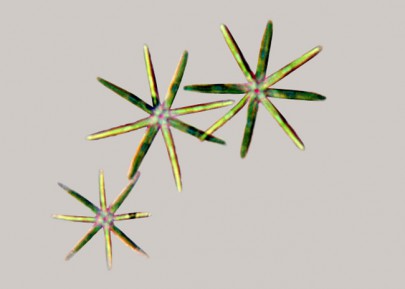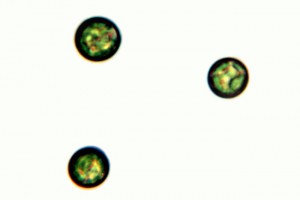Chlorophytes
In this section

Actinastrum (sewage pond), X640.
As in other green algae, chlorophytes store starch in their chloroplasts, which contain chlorophylls a and b. Chlorophytes are extremely diverse, and include both freshwater and marine representatives. They include Chlorella, which was famously used to elucidate the “dark reactions” of photosynthesis, and Chlamydomonas, which is the source of most of our knowledge of chloroplast genetics. Some are used to produce compounds for commercial applications, such as Haematococcus for its red carotenoids.
Chlamydomonas is a good representation of the basic chlorophyte unit, being a single cell with two equal-length flagella emerging symmetrically from its apex (four such flagella is another common number). Although many chlorophytes are filamentous, they have usually retained these types of cells somewhere in their life cycle, for instance at the gamete stage. However, these cells are rarely seen in field material. Some unicellular and colonial taxa have dispensed with flagellated stages altogether – at least as far as we know.
Distinctive groups of freshwater chlorophytes include those that form coenobial colonies – groups of cells of a characteristic number and shape, which give rise to daughter colonies directly. Scenedesmus is an example. Another group comprise colonies of Chlamydomonas-like cells embedded in a large gelatinous sphere, with the flagella directed outwards. The whole colony is motile and exhibits cellular differentiation (for example, Volvox). Oedogonium and its relatives, on the other hand, are filamentous, and display a bewildering diversity of life cycles. This includes the innovation of “dwarf males” in some species – an adaptation that maximises resource efficiency and ensures that sperm cells are produced in close proximity to fertile female cells.
Some chlorophytes, such as Ulva, occupy brackish habitats. Ulva is familiar to many as sea lettuce, but other species can tolerate substantial freshwater influence. Ulothrix also has both marine and freshwater representatives, showing that this group of chlorophytes have invaded fresh waters on more than one occasion in their evolutionary past.

![[Actinastrum] (sewage pond), X640. Photo: Otago Regional Council & Manaaki Whenua](/assets/Tools-And-Resources/Identification/algae/actinastrum640__FillMaxWzMwMCwyMDBd.jpg)
![[Bulbochaete], Kakanui River, north Otago, X7. Photo: Otago Regional Council & Manaaki Whenua](/assets/Tools-And-Resources/Identification/algae/bulbochaete7__FillMaxWzMwMCwyMDBd.jpg)
![[Chlamydomonas], X1000. Photo: Phil Novis, Manaaki Whenua](/assets/Tools-And-Resources/Identification/algae/chlamydomonas_phil1000__FillMaxWzMwMCwyMDBd.jpg)

![[Cladophora], Wairuna River, Otago. Photo: Otago Regional Council & Manaaki Whenua](/assets/Tools-And-Resources/Identification/algae/cladophora2__FillMaxWzMwMCwyMDBd.jpg)
![[Dictyosphaerium], Lake Rotoiti, X640. Photo: Manaaki Whenua](/assets/Tools-And-Resources/Identification/algae/dictyosphaerium640__FillMaxWzMwMCwyMDBd.jpg)
![[Haematococcus], X400. Photo: Taranaki Regional Council & Manaaki Whenua](/assets/Tools-And-Resources/Identification/algae/haematococcus2__FillMaxWzMwMCwyMDBd.jpg)
![[Hydrodictyon], Saltwater Creek, Hawkes Bay, X40. Photo: Otago Regional Council & Manaaki Whenua](/assets/Tools-And-Resources/Identification/algae/hydrodictyon40k__FillMaxWzMwMCwyMDBd.jpg)
![[Oedogonium], Shag River, north Otago. Photo: Otago Regional Council & Manaaki Whenua](/assets/Tools-And-Resources/Identification/algae/oedogonium3__FillMaxWzMwMCwyMDBd.jpg)
![[Scenedesmus] (sewage pond), X640. Photo: Manaaki Whenua](/assets/Tools-And-Resources/Identification/algae/scenedesmus640__FillMaxWzMwMCwyMDBd.jpg)
![[Ulothrix], X200. Photo: Phil Novis, Manaaki Whenua](/assets/Tools-And-Resources/Identification/algae/ulothrix_phil200__FillMaxWzMwMCwyMDBd.jpg)
![[Ulva], Waipori estuary, Otago, X320. Photo: Otago Regional Council & Manaaki Whenua](/assets/Tools-And-Resources/Identification/algae/ulva320__FillMaxWzMwMCwyMDBd.jpg)
![[Volvox], Auckland stormwater pond, X100. Photo: Manaaki Whenua](/assets/Tools-And-Resources/Identification/algae/volvox100b__FillMaxWzMwMCwyMDBd.jpg)